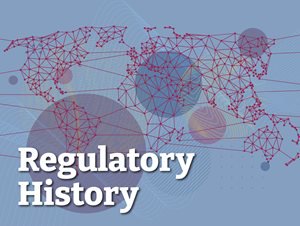RF Quarterly
Posted 27 June 2022 | By
| ![]() PDF
PDF
RF Quarterly, June 22: Regulatory history
2731
Welcome to the June issue of RF Quarterly in which global regulatory experts write about Japan’s Pharmaceuticals and Medical Devices Agency (PMDA), medical device regulations in China’s National Medical Products Administration (NMPA), and a personal reflection on 3 decades at the International Council for Harmonisation (ICH). Also included are articles on the development of clinical trial disclosure requirements, expedited pathways, and the De Novo pathway and the Final Rule.
We thank the authors for their generosity in sharing their knowledge and expertise with the RAPS regulatory community and hope their articles and will serve as useful guidance and resources. The articles in this issue mark the beginning of a series on histories of other pathways and national and regional regulatory agencies and organizations.
Agencies and organizations
Japanese regulators have leveraged the lessons learned in recent decades to refine and enhance the country’s postwar regulatory system, making it one of the most effective systems in the world, writes Susumu Nozawa in Evolution of the Japanese regulatory system and agencies. Beginning with the Edo period of 1603-1867, Nozawa tracks the key events that have driven and shaped the laws and regulations governing drug and medical device oversight. He discusses Japan’s growing focus on forging regional and international collaborations and explains the delegation of responsibilities between the various agencies, including the Ministry of Health, Labour and Welfare and the PMDA.
In China’s NMPA: The evolution of medical device regulation, Grace Palma and Tina Zhao describe the main changes in China’s drug and device regulatory system over the past 70 years, with a focus on medical devices. Among those changes are the introduction of new systems for marketing authorization, conditional approval, and clinical trial management and evaluation. The NMPA, China’s regulatory agency, is a complex and expansive multilevel entity that has undergone considerable restructuring to keep abreast with domestic regulatory changes and support broader international regulatory cooperation. The authors present some anticipated regulatory updates, including reform of the review and approval system and strengthening of postmarketing surveillance.
David Jefferys has been involved with the ICH as both regulator and an industry participant for more than 3 decades. In The ICH over the last 30 years: A personal reflection, he shares his recollections of the council’s expansion from an international organization involving three regions – the US, European Community, and Japan – to a fully global body. Jefferys provides insights into the expert working groups and their focus on generating guidelines for pharmaceuticals, initially on Safety, Efficacy, and Quality and later, Methodological Issues as well. He notes that the Global Harmonization Task Force’s approach in its work on medical devices and in vitro diagnostics concentrates on reconciling regulatory principles rather than generating guidelines, effectively making the process one of regulatory convergence rather than harmonization.
Pathways, guidelines, and clinical trials
In The history of clinical trial disclosure, Thomas Wicks outlines the transparency milestones in clinical trial disclosure to ensure global compliance. The scope and complexity of requirements for global clinical trial disclosures and data sharing have increased substantially in recent years. Numerous countries have tailored regulations on trial conduct, and some have patient registries for gathering data.
In A history of expedited pathways: Breakthrough therapy designation, PRIME, Sakigake, and ILAP, Maurice Bancsi reviews the and achievements of the US Food and Drug Administration’s breakthrough therapy designation, the European Medicines Agency’s priority medicines scheme, the Sakigake initiative from Japan’s PMDA, and the UK’s innovative licensing and access pathway. He notes that eligibility requirements and benefits of the respective pathways are comparable. Success rates vary across regions, ranging from 90% approvals in the UK to 25% in the EU, but there is insufficient evidence that similar rates apply to approvals in the US and Japan.
In The evolution of the De Novo pathway, Waleed Shabana and Tahir Rizvi provide an overview of the regulatory history of the De Novo pathway, from its initial introduction in the Food and Drug Administration Modernization Act in 1997 to the Final Rule implementation in 2022. They summarize the establishing acts and guidances that have culminated in the regulation, emphasizing changes in the process exploring the impact of each decision. Given the rapidly changing regulatory environment, the authors suggest industry need to remain current on all available regulatory pathways and supporting regulatory resources so that they are better equipped to determine which pathway they should follow when submitting an application.
About the lead editors
Daniel Mannix, PhD, is chair of the RAPS editorial advisory committee and vice president, regulatory affairs, at MacroGenics. He has more than 28 years of pharmaceutical regulatory affairs experience in positions of increasing responsibility at Pharmacia, BMS, EMD Serono, and Kyowa Hakko Kirin across multiple therapeutic areas, with a focus in oncology.
Robert Falcone, PhD, FRAPS, is a member of the RAPS editorial advisory committee and senior regulatory affairs manager at Prestige Consumer Healthcare, working with Rx and OTC products sold in the US and Canada. He has held various leadership positions representing global healthcare organizations selling in the US, Canada, Europe, Mexico, Brazil, and China. His specialty areas include active pharmaceutical ingredients for human and animal prescription applications, veterinary and human drugs, medical devices, and combination and dermatological products.
Citation Mannix D, Falcone R. Introduction: Regulatory history. RF Quarterly. 2022;2(2):1-2. Published online 27 June 2022. https://bit.ly/3QPKEg2
Upcoming in RF Quarterly
- Strategy in regulatory affairs (September 2022)
- Artificial intelligence (December 2022)
Previous issues
To contribute, email Renee Matthews, Senior Editor, at rmatthews@raps.org For more information, see Guidelines for Authors and the 2022 Editorial Calendar.
© 2022 Regulatory Affairs Professionals Society.

